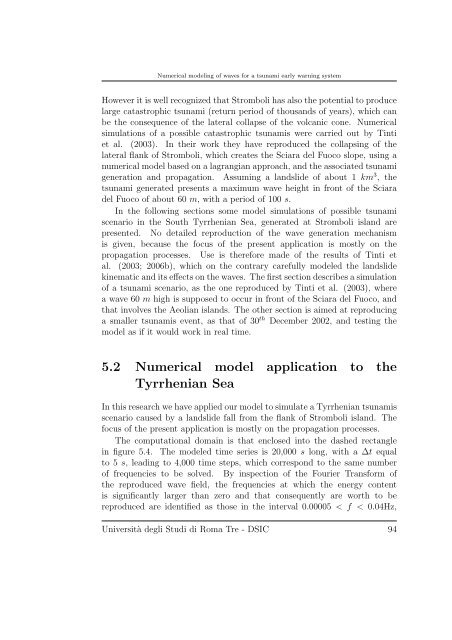Numerical modeling of waves for a tsunami early warning system
Numerical modeling of waves for a tsunami early warning system
Numerical modeling of waves for a tsunami early warning system
You also want an ePaper? Increase the reach of your titles
YUMPU automatically turns print PDFs into web optimized ePapers that Google loves.
<strong>Numerical</strong> <strong>modeling</strong> <strong>of</strong> <strong>waves</strong> <strong>for</strong> a <strong>tsunami</strong> <strong>early</strong> <strong>warning</strong> <strong>system</strong><br />
However it is well recognized that Stromboli has also the potential to produce<br />
large catastrophic <strong>tsunami</strong> (return period <strong>of</strong> thousands <strong>of</strong> years), which can<br />
be the consequence <strong>of</strong> the lateral collapse <strong>of</strong> the volcanic cone. <strong>Numerical</strong><br />
simulations <strong>of</strong> a possible catastrophic <strong>tsunami</strong>s were carried out by Tinti<br />
et al. (2003). In their work they have reproduced the collapsing <strong>of</strong> the<br />
lateral flank <strong>of</strong> Stromboli, which creates the Sciara del Fuoco slope, using a<br />
numerical model based on a lagrangian approach, and the associated <strong>tsunami</strong><br />
generation and propagation. Assuming a landslide <strong>of</strong> about 1 km 3 , the<br />
<strong>tsunami</strong> generated presents a maximum wave height in front <strong>of</strong> the Sciara<br />
del Fuoco <strong>of</strong> about 60 m, with a period <strong>of</strong> 100 s.<br />
In the following sections some model simulations <strong>of</strong> possible <strong>tsunami</strong><br />
scenario in the South Tyrrhenian Sea, generated at Stromboli island are<br />
presented. No detailed reproduction <strong>of</strong> the wave generation mechanism<br />
is given, because the focus <strong>of</strong> the present application is mostly on the<br />
propagation processes. Use is there<strong>for</strong>e made <strong>of</strong> the results <strong>of</strong> Tinti et<br />
al. (2003; 2006b), which on the contrary carefully modeled the landslide<br />
kinematic and its effects on the <strong>waves</strong>. The first section describes a simulation<br />
<strong>of</strong> a <strong>tsunami</strong> scenario, as the one reproduced by Tinti et al. (2003), where<br />
awave60m high is supposed to occur in front <strong>of</strong> the Sciara del Fuoco, and<br />
that involves the Aeolian islands. The other section is aimed at reproducing<br />
a smaller <strong>tsunami</strong>s event, as that <strong>of</strong> 30 th December 2002, and testing the<br />
model as if it would work in real time.<br />
5.2 <strong>Numerical</strong> model application to the<br />
Tyrrhenian Sea<br />
In this research we have applied our model to simulate a Tyrrhenian <strong>tsunami</strong>s<br />
scenario caused by a landslide fall from the flank <strong>of</strong> Stromboli island. The<br />
focus <strong>of</strong> the present application is mostly on the propagation processes.<br />
The computational domain is that enclosed into the dashed rectangle<br />
in figure 5.4. The modeled time series is 20,000 s long, with a Δt equal<br />
to 5 s, leading to 4,000 time steps, which correspond to the same number<br />
<strong>of</strong> frequencies to be solved. By inspection <strong>of</strong> the Fourier Trans<strong>for</strong>m <strong>of</strong><br />
the reproduced wave field, the frequencies at which the energy content<br />
is significantly larger than zero and that consequently are worth to be<br />
reproduced are identified as those in the interval 0.00005

















